Thryptomene caduca is a species of flowering plant in the family Myrtaceae and is endemic to a small area in the north-west of Western Australia. It is a spreading shrub with crowded egg-shaped leaves with the narrower end towards the base, and pink flowers with five petals and seven to nine stamens.
Thryptomene pinifolia is a species of flowering plant in the family Myrtaceae and is endemic to Kalbarri National Park in Western Australia. It is a shrub with linear leaves, and flowers with pale pinkish sepals and petals and seven or eight stamens.
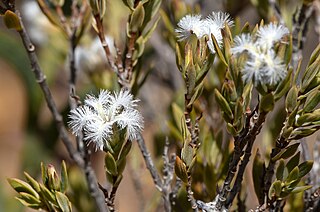
Leucopogon foliosus is a species of flowering plant in the heath family Ericaceae and is endemic to the south-west of Western Australia. It is a low, spreading shrub with hairy young branchlets, spirally arranged, erect, linear, narrowly egg-shaped to narrowly elliptic leaves, and white, narrowly bell-shaped flowers.
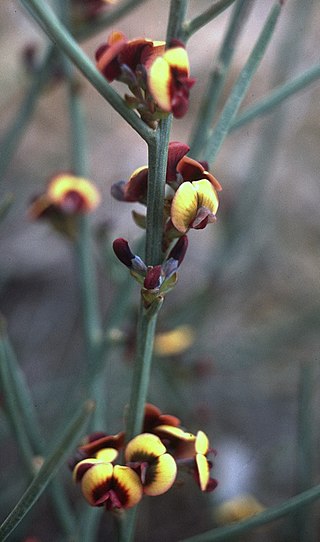
Daviesia debilior is a species of flowering plant in the family Fabaceae and is endemic to the south-west of Western Australia. It is a shrub with low-lying stems and many erect branchlets, scattered linear to scale-like phyllodes, and yellow, purplish, orange-pink and dark purplish flowers.

Lasiopetalum oppositifolium is a species of flowering plant in the family Malvaceae and is endemic to the south-west of Western Australia. It is an open, erect shrub with rusty-hairy young stems, linear, narrowly elliptic or narrowly egg-shaped leaves and white, pink and dark red flowers.
Mirbelia balsiformis is a species of flowering plant in the family Fabaceae and is endemic to the far west of Western Australia. It is an erect to sprawling shrub with leaves reduced to triangular scales, and yellow to orange and red flowers arranged in racemes on the side of the branchlets.
Mirbelia ferricola is a species of flowering plant in the family Fabaceae and is endemic to inland parts of the south-west of Western Australia. It is an erect shrub with leaves reduced to small scales, and red and yellow flowers arranged in racemes at the ends of the branches.
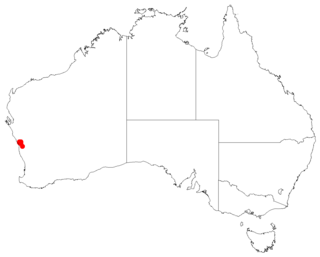
Leucopogon grammatus is a species of flowering plant in the heath family Ericaceae and is endemic to the south-west of Western Australia. It is an erect shrub with hairy young branchlets, spirally arranged, erect, egg-shaped leaves, and white, bell-shaped to broadly bell-shaped flowers.
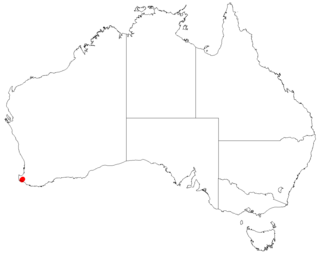
Leucopogon incisus is a species of flowering plant in the heath family Ericaceae and is endemic to a small area in the far south of the south-west of Western Australia. It is a delicate, erect or sprawling shrub with glabrous young branchlets, spirally arranged, erect, narrowly egg-shaped to narrowly elliptic leaves, and white or pale pink, narrowly bell-shaped to more or less cylindrical flowers.

Leucopogon inflexus is a species of flowering plant in the heath family Ericaceae and is endemic to the south-west of Western Australia. It is an erect, open shrub with more or less glabrous young branchlets, spirally arranged, erect, egg-shaped to more or less round leaves, and white, bell-shaped, densely bearded flowers.
Cryptandra minutifolia is a flowering plant in the family Rhamnaceae and is endemic to the south-west of Western Australia. It is a spreading shrub with oblong to elliptic leaves and clusters of white or pink, tube-shaped flowers.
Thomasia × formosa is a species of flowering plant in the family Malvaceae and is endemic to a restricted area of the south-west of Western Australia. It is an erect, compact shrub with densely hairy branchlets, hairy, coarsely serrated, egg-shaped to elliptic or oblong leaves, and racemes of pink or purple flowers arranged in leaf axils.
Conostephium laeve is a species of flowering plant in the family Ericaceae and is endemic to the west of Western Australia. It is a compact shrub with erect, narrowly elliptic or narrowly egg-shaped leaves with the narrower end toward the base, and pendulous, spindle-shaped, cream to straw-coloured and pink flowers.

Pimelea leucantha is a species of flowering plant in the family Thymelaeaceae and is endemic to near-coastal areas in the west of Western Australia. It is a shrub with linear to narrowly egg-shaped or narrowly elliptic leaves and clusters of white to pale yellow flowers surrounded by 4 or 6 egg-shaped involucral bracts.
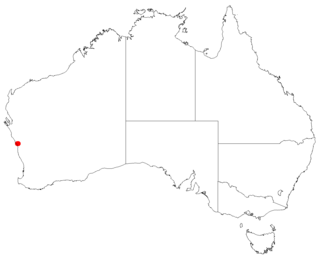
Leucopogon navicularis is a species of flowering plant in the heath family Ericaceae and is endemic to the southwest of Western Australia. It is an erect, compact shrub with hairy young branchlets, narrowly elliptic to narrowly egg-shaped leaves and erect, compact clusters of 4 to 12 white, bell-shaped flowers in upper leaf axils or on the ends of branches.
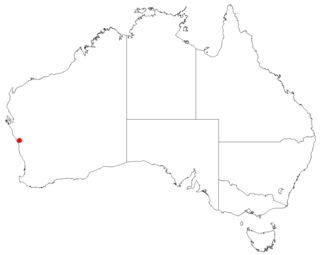
Leucopogon nitidus is a species of flowering plant in the heath family Ericaceae and is endemic to a small area in Western Australia. It is an erect, open shrub with hairy young branchlets, linear or very narrowly elliptic leaves and erect, compact clusters of 3 to 8 white flowers on the ends of branches and in upper leaf axils.

Leucopogon prolatus is a species of flowering plant in the heath family Ericaceae and is endemic to the south-west of Western Australia. It is an erect, open shrub with a single stem at ground level, egg-shaped to elliptic leaves and erect clusters of 3 to 14 white flowers on the ends of branches and short side-branches.

Leucopogon stenophyllus is a species of flowering plant in the heath family Ericaceae and is endemic to the south-west of Western Australia. It is an erect, open shrub with a single stem at ground level, linear, narrowly egg-shaped or narrowly elliptic leaves and erect clusters of 3 to 17 white flowers on the ends of branches and short side-branches.

Leucopogon stokesii is a species of flowering plant in the heath family Ericaceae and is endemic to a small area in the south-west of Western Australia. It is an erect, open shrub with hairy young branchlets, narrowly elliptic leaves and erect, dense clusters of 5 to 10 bell-shaped white flowers on the ends of branches.

Leucopogon tenuicaulis is a species of flowering plant in the heath family Ericaceae and is endemic to the far southwest of Western Australia. It is an erect or sprawling shrub with thin stems, upright triangular to narrowly egg-shaped or narrowly elliptic leaves and erect, white or pale pink, tube-shaped flower arranged in large groups on the ends of branches and in upper leaf axils.












